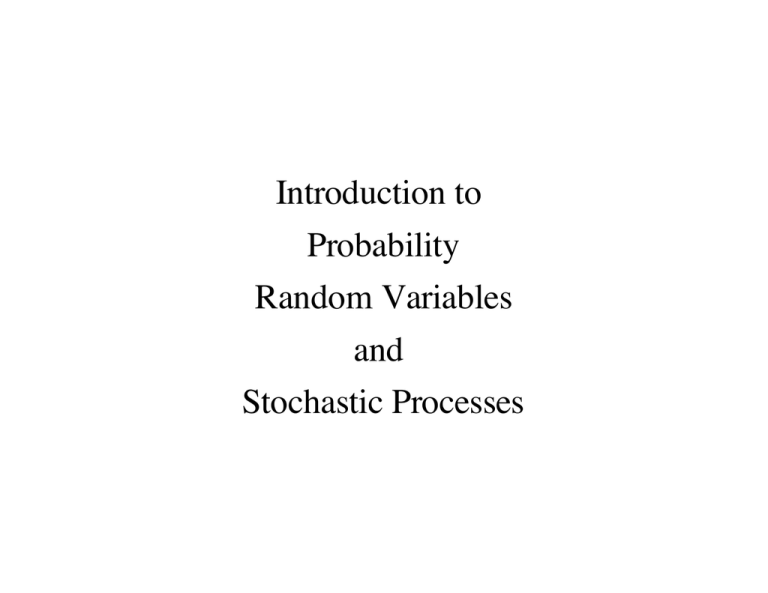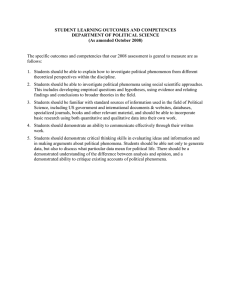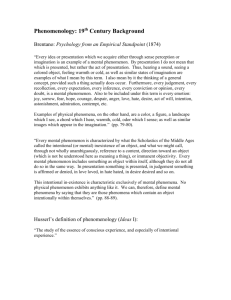Introduction to Probability Random Variables and
advertisement

Introduction to Probability Random Variables and Stochastic Processes Randomness •Many phenomena that are important in engineering seem to be random. •A practical engineering definition of a random phenomenon is one whose behavior is either actually unpredictable, or is so complicated that we don’t know how to, or don’t have time to, predict its future behavior. •A truly random phenomenon would be one that varies for no reason. That is, its exact behavior is spontaneous and not governed by a scientific principle that would make predictable. •Is it really possible that events occur for no reason? Whether or not a phenomenon actually does occur spontaneously, or just seems to, is a distinction better left to philosophers. Probability •Probability is a measure of how likely any particular event is to occur. •Analysis of random phenomena is often called probabilistic analysis. •The oldest classical examples of random phenomena arise from games of chance like craps, roulette and card games. •Much of the theory of probability was developed in Europe to ensure that owners of casinos would make a profit. Probability •The beginning of probabilistic analysis is generally taken to be in 1654 when two French mathematicians Blaise Pascal and Pierre de Fermat took up a question about a game of chance posed by Antoine Gombaud, Chevalier de Méré, a French nobleman. •The first book on probability entitled De Ratiociniis in Ludo Aleae, was published by Christian Huygens. •Later, two big contributors to probability theory were Jakob Bernoulli (1654-1705) and Abraham de Moivre (1667-1754). •In 1812 Pierre de Laplace (1749-1827) wroteThéorie Analytique des Probabilités. •Before Laplace, probability theory dealt only with games of chance. Laplace widened its application to many scientific problems. •Others who have advanced theories of probability since Laplace’s time are Chebyshev, Markov, von Mises, and Kolmogorov. Random Phenomena •Consider the game of craps. The “shooter” tosses the dice against a wall at the end of a table and each die comes to rest on the table with one side facing up. The sum of the two numbers of dots on the top faces determines who wins and loses. •The final resting positions of the two dice are not actually random in the strict sense. They are determined by the initial positions and orientations of the dice and their initial linear and rotational velocities as they leave the shooter’s hand along with the geometrical layout of the table and the textures of the surfaces onto which they are tossed and of the dice themselves. •The computation and prediction of those final positions is practically impossible. •This is an example of a phenomenon which, although not actually random, is treated as random for practical reasons. The same reasoning can be applied to the other casino games like roulette and card games. Random Phenomena •Many states in the US now have lotteries and use a stochastic process to select the winning numbers. •A very common one is a clear plastic container with several ping pong balls in it. Each ball has a different numerical digit on it. The balls are put into motion by a jet of air introduced into the container. When a ball comes near the air jet it is accelerated. •All the balls are moving because each one collides with others and with the container wall in a complicated pattern. •At some point in time some of the balls are taken out of the container by allowing them to exit through a vertical tube. The sequence of numbers on the balls is the winning number. •It would be theoretically possible to predict the motion of each ball and therefore know which one would exit the container at any specified time. •But the computation would be extremely complicated and would depend heavily on the initial conditions. Random Phenomena •Consider a child’s toy balloon filled with helium. Inside the balloon are helium atoms in motion. The movement of the helium atoms is similar to the movement of the ping pong balls in the lottery. •In this case the number of colliding bodies is much greater, on the order of 1019 atoms per cubic centimeter. •The ping-pong-ball motion problem was computationally very complicated. The heliumatom motion problem is astronomically more complicated. No computer in the world could solve it in a reasonable time. •We usually don’t actually care about the individual atom motions. What we need to know are, for example, the gas pressure inside the balloon, how big the balloon is, or what happens if the gas is heated. •These questions can all be answered to very high precision by treating the gas as a collective entity with certain statistical properties. •The branch of physics that deals with this type of problem is called statistical mechanics. •This is an example of stochastic process theory applied to a natural phenomenon. Random Phenomena •Another example of the application of stochastic process theory is the analysis of the phenomenon called Johnson Noise in electrical components. •All materials at temperatures above absolute zero contain some “free” electrons that can move enough to conduct electrical current. •As they move, the free electrons collide with the bound electrons in the outer shells of the atoms and with each other. The movement is too complicated to try to predict in detail. •Since electrons are charged particles, their movement constitutes a current. If the lead wires of an ordinary resistor are connected together a random current i ( t ) will flow. •It has been shown (first by E. B. Johnson of Bell Labs) that the average value of this current is zero and that the power of this current is directly proportional to the absolute temperature of the material that contains the free electrons and inversely proportional to its electrical resistance Random Phenomena •If the resistor wire leads are left open, the random motion of the free electrons causes a time-varying random voltage v ( t ) across the resistor whose average value is zero and whose power is directly proportional to absolute temperature and directly proportional to its resistance. Random Phenomena Below is a sequence of 10 numbers taken from a much longer sequence. , 8,13, 21, 34, 55, 89,144, 233, 377, 610, Is the longer sequence random? A little thought will lead to the discovery that each number (after the first two) is the sum of the previous two numbers. So a natural conclusion would be that this sequence is not random because the next number in the sequence can be predicted. But what is the number after 610? Is it 987? If it is not, the algorithm breaks down and we can no longer say that the next number is predictable. So without seeing the entire sequence (which might be infinitely long) we cannot determine whether the longer sequence is random. And, even if we did examine the entire sequence, we could only detect that it is non-random if we could find a predictable pattern. We could never really be sure a sequence is random.





